The Biocompatible 3D Printing Materials Market: Revolutionizing Healthcare Manufacturing
The intersection of 3D printing technology and healthcare
has created one of the most promising markets in additive manufacturing: biocompatible
3D printing materials. This rapidly evolving sector is transforming how
medical devices, dental appliances, and surgical tools are designed and
manufactured, offering unprecedented customization and precision for patient
care.
Explore the full report - https://futuremarketanalytics.com/report/biocompatible-3d-printing-materials-market/
Market Growth and Size
The biocompatible 3D printing materials market is
experiencing remarkable growth, driven by increasing demand in healthcare
settings. Current market valuations show significant momentum, with the global
market size estimated at USD 664.7 million in 2024 and projected to grow at a
compound annual growth rate (CAGR) of 14.6% through 2030. Some analysts project
even more aggressive growth, with forecasts suggesting the market could reach
between USD 1.75 billion and USD 3.5 billion by the early 2030s, depending on
technological adoption rates and regulatory approvals.
The North American market leads this expansion, with the
United States alone accounting for USD 362 million in 2024. This dominance
reflects the region's advanced healthcare infrastructure, aging population, and
early adoption of innovative medical technologies.
Key Applications Driving Demand
Biocompatible 3D printing materials serve diverse
applications across the healthcare spectrum. In the medical field, these
materials are essential for creating custom prosthetics, orthopedic implants,
and surgical guides that require direct patient contact. The dental industry
has emerged as a particularly strong adoption segment, utilizing biocompatible
resins for crowns, bridges, aligners, and surgical templates.
Advanced applications include tissue engineering and
regenerative medicine, where materials must support cell growth and integrate
with biological systems. These cutting-edge uses require materials that are not
only biocompatible but also biodegradable, allowing for gradual absorption as
natural tissue regenerates.
Material Categories and Innovation
The market encompasses several material categories, each
serving specific applications. Polymer-based materials dominate current usage,
offering versatility and cost-effectiveness for applications requiring skin
contact lasting over 30 days or mucosal membrane contact up to 24 hours.
Popular examples include medical-grade resins like MED625FLX, MED610, and
MED620, which provide precise visualization capabilities for medical and dental
applications.
Metal biocompatible materials, particularly titanium and
medical-grade stainless steel, represent the high-value segment of the market.
These materials offer superior strength, durability, and biocompatibility,
making them ideal for permanent implants such as joint replacements, dental
implants, and load-bearing prosthetics. Advanced manufacturing techniques like
direct metal laser sintering (DMLS) have expanded the possibilities for complex
geometries and internal structures previously impossible to achieve through
traditional manufacturing.
Market Drivers and Challenges
Several factors are propelling market growth. The aging
global population creates increasing demand for medical devices and implants.
Personalized medicine trends favor 3D printing's ability to create
patient-specific solutions. Additionally, the technology's capacity to reduce
surgical times, improve patient outcomes, and enable rapid prototyping appeals
to healthcare providers seeking efficiency and innovation.
However, the market faces significant challenges. Stringent
regulatory requirements for medical device approval can slow product
development and market entry. The need for extensive biocompatibility testing
according to standards like ISO 10993 adds complexity and cost to material
development. Additionally, the requirement for specialized sterilization
processes, including ethylene oxide, gamma irradiation, and steam autoclave
methods, demands careful material selection and validation.
Future Outlook
The biocompatible 3D printing materials market stands at the
forefront of healthcare innovation. As material science advances and regulatory
pathways become more established, the market is poised for continued expansion.
Emerging applications in organ printing, drug delivery systems, and smart
implants with integrated sensors represent the next frontier of growth.
The convergence of improved material properties, enhanced 3D
printing technologies, and growing healthcare needs positions this market as a
cornerstone of future medical manufacturing, promising more personalized,
effective, and accessible healthcare solutions worldwide.




Comments
Post a Comment